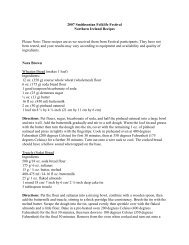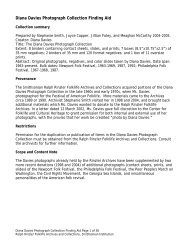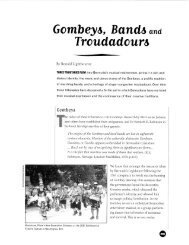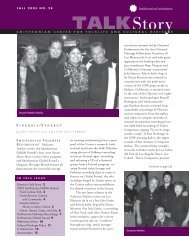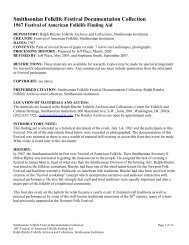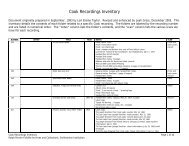Who Owns Traditional Medical Knowledge? - Smithsonian Center ...
Who Owns Traditional Medical Knowledge? - Smithsonian Center ...
Who Owns Traditional Medical Knowledge? - Smithsonian Center ...
Create successful ePaper yourself
Turn your PDF publications into a flip-book with our unique Google optimized e-Paper software.
184 SITA REDDY<br />
63. Reddy, “The Politics and Poetics of Magazine Medicine.”<br />
64. CBD, 1992, Article 2.<br />
65. See Hayden, When Nature Goes Public, for an excellent ethnography of benefit-sharing. See<br />
also Hayden’s “Benefit-sharing” for an overview of benefit-sharing agreements in relation to IP law.<br />
66. See Gupta, “Value-Addition to Local Kani Tribe <strong>Knowledge</strong>,” for an in-depth account and<br />
evaluation of the benefit-sharing scheme with the Kani tribe.<br />
67. The Indian Constitution, 73 rd Amendment Act, 1992. For more information, see the Goverment<br />
of India Ministry of Pancayat Raj’s National Pancayati Portal, http://panchayat.nic.in accessed<br />
September 24, 2006.<br />
68. Report of the Tropical Botanic Garden Research Institute, 2005.<br />
69. See G. Rajiv, “U.S. Firm Patents Kerala Tribe’s Jeevani,” January 6, 2006, http://<br />
www.indiamonitor.com accessed July 15, 2006.<br />
70. For other work on the past as heritage resource, see Appadurai, “The Past as a Scarce Resource,”<br />
for an early articulation of the argument; see also Harrison, “Identity as a Scarce Resource.”<br />
For the past as cultural and intellectual properties, see Nicholas and Bannister, “Copyrighting the<br />
Past”<br />
71. See for example Michael Davis, “Some Realism About Indigenism.”<br />
BIBLIOGRAPHY<br />
Agrawal, Arun. “Indigenous <strong>Knowledge</strong> and the Politics of Classification.” International Social Science<br />
Journal 54 (2002): 173, 287–297<br />
Aoki, Keith. “Intellectual property and sovereignty: Notes toward a cultural geography of authorship.”<br />
Stanford Law Review 48 (1996) no. 5: 1293–1355.<br />
Appadurai, Arjun. Modernity at Large: Cultural Dimensions of Globalization. Delhi: Oxford University<br />
Press, 1996.<br />
———. “The Past as Scarce Resource.” Man, N.S. 16 (1981): 201–219.<br />
Appiah, Kwame Anthony. Cosmpolitanism: Ethics in a World of Strangers. NewYork:W.W.Norton,<br />
2006.<br />
Bala, Poonam. Imperialism and Medicine in Bengal: A Soci-Historical Perspective. New Delhi: Sage<br />
Publications, 1991.<br />
Bannister, Kelly, and Katherine Barrett. “Challenging the Status Quo in Ethnobotany: A New Paradigm<br />
for Publication May Protect Cultural <strong>Knowledge</strong> and <strong>Traditional</strong> Resource.” Cultural Survival<br />
Quarterly 24, no. 4 (2001): 10–13.<br />
Barsh, Russel L. “How Do You Patent a Landscape The Perils of Dichotomizing Cultural and Intellectual<br />
Property.” International Journal of Cultural Property 8, no. 1 (1990): 14–47.<br />
Bates, Don, ed. <strong>Knowledge</strong> and the Scholarly <strong>Medical</strong> Traditions. Cambridge: Cambridge University<br />
Press, 1995.<br />
Benjamin, Walter. “The work of Art in the Age of Mechanical Reproduction.” in Illuminations, 217–<br />
251. New York. Schocken Books, 1969.<br />
Boxer, C.R. “Two Pioneers of Tropical Medicine: Garcia d’Orta and Nicolas Monardes.” Diamante<br />
1963, XIV, 133.<br />
Boyle, James. Shamans, Software, and Spleens: Law and the Construction of The Information Society.<br />
Cambridge: Harvard University Press, 1999.



